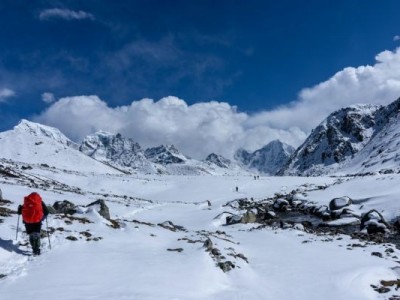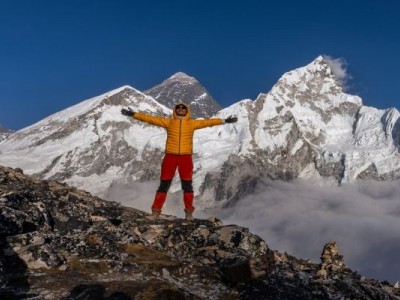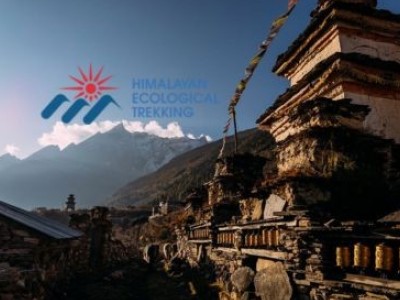The Langtang Valley trek in spring provides trekkers with a remarkable trip through one of Nepal's most accessible yet beautiful Himalayan valleys. The trek showcases splendid glaciers, colorful rhododendron forests, and the rich Tamang culture while trekking along traditional mountain villages and experiencing the stunning landscapes of Langtang National Park. Many trekkers recognize March to May to be the best season for the Langtang Valley trek—characterized by crystal-clear skies, moderate temperatures, and blooming alpine meadows, the spring season is the best time for novice to very experienced trekkers seeking an authentic Himalayan experience.
Table of Contents
Why is the Langtang Valley Trek in Spring the Best Choice?
Located just north of the capital city of Kathmandu, Langtang Valley is a stunning trekking region that spans from 1,500 to 4,984m in elevation. The Langtang Valley trek in spring is a phenomenal chance to enjoy this remarkable valley in superb conditions. Spring (March-May) transforms Langtang Valley into a wildflower paradise, especially notable rhododendrons and primulas, with all of the snow-covered peaks such as Langtang Lirung (7,227m), Gang Chhenpo, etc. Trekking in the spring to Langtang Valley is ideal for both nature lovers and mountain photographers. Known as the "Valley of Glaciers", Langtang Valley comes alive after its winter slumber with a spectacular display of color and flora. The journey to Langtang Valley is affordable and rewarding, as it is within a shorter distance from Kathmandu than most other trekking experiences.
- Related article: Best Time to Trek Langtang Valley: A Complete Seasonal Guide
Langtang Valley Spring Weather
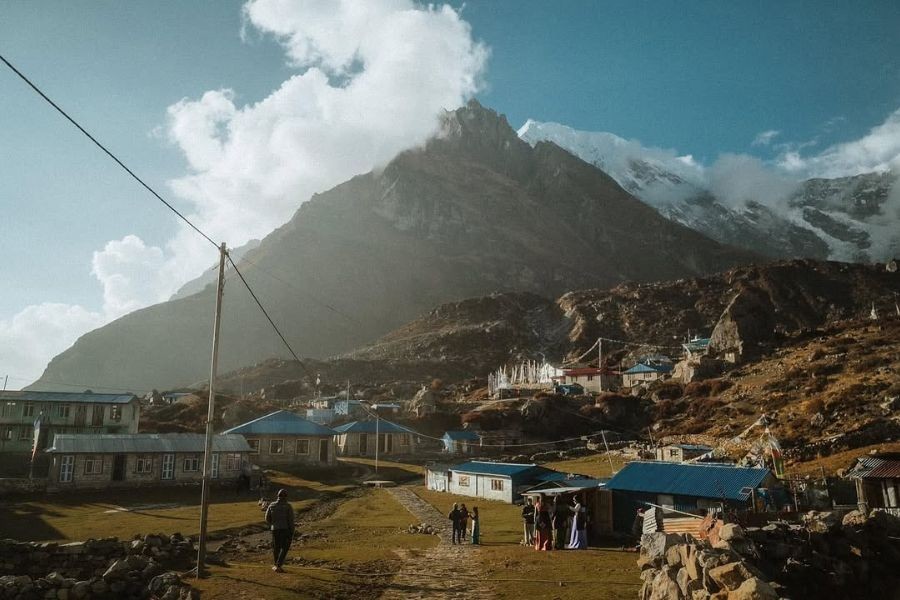
March to May is generally regarded as the best trekking season in Langtang Valley. Daytime temperatures can be anywhere between 10°C to 20°C at lower elevations, and during the night temperatures can drop to around -5°C to 5°C. The skies are often perfectly clear, ensuring there is no obstruction in views to the magnificent Himalayan peaks. There may be some light rain in the late afternoon to brush off the dust from the air or to create a kind of magical glow to the natural beauty around the area.
The colors emerge from the thawing winter snow, ideal for rhododendron trekking in Nepal, and weather is stable so that each morning would ensure both consistency for trekking and reward with mountain views.
Why Spring is the Best Season to Trek in Langtang Valley
Ideal Weather for Amazing Views
In spring, the weather is mild with excellent visibility. The view of Langtang Lirung and the Tibetan peaks is pleasant for trekkers. With longer daylight hours, spring is the best time to walk on a glacier, ascend to viewpoints like Tserko Ri, and immerse yourself in the culture.
Quiet, Less Crowded Trails
Langtang Valley is less crowded than trekking in Everest or Annapurna in late spring. Trekkers can visit Tamang villages and enjoy the real Himalayan culture without the hustle and bustle of being on a tight tourist schedule.
Bouncing Flora and Fauna
The hillside develops into a frolicking floral wonderland with the blooming of rhododendrons, primlap, and blue poppies. Wildlife like red pandas, Himalayan tahr, and colorful birds like Himalayan monal will also begin to appear.
The Beauty of Spring on the Langtang Valley Trek
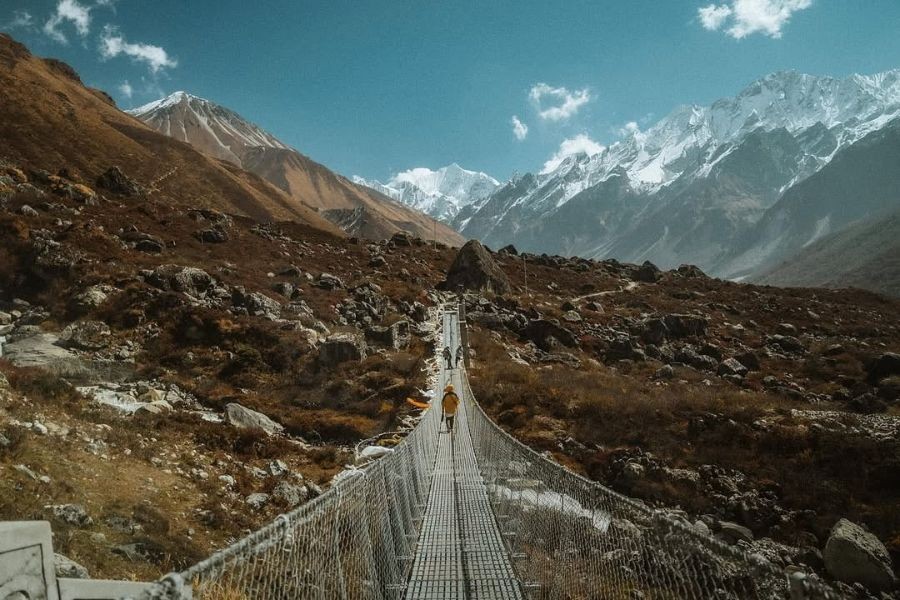
Langtang in Bloom: The Wonder of Spring Colors
Rhododendron forests and alpine meadows radiate red, pink, and white across the valley. The traditional Tamang villages and fluttering prayer flags further add a cultural vibrance to the scenery.
Remarkable Snow-Capped Peaks and Glaciers
Viewpoints like Kyanjin Ri (4,773m) and Tserko Ri (4,984m) reward trekkers with panoramic views of Langtang Lirung, Dorje Lakpa, Gangchenpo, and more. The snow-capped peaks shimmer in the spring sunlight, creating picture-perfect moments.
Tranquil Atmosphere
Cool breezes, chirping birds, and the sound of rivers creates a meditative environment. The Langtang Valley trek in spring provides a peaceful and spiritual connection to nature.
Cultural Richness and Spiritual Heritage
The trek is culturally rich due to the Tamang and Tibetan influences in Langtang. Villages such as Langtang and Kyanjin Gompa are home to historic monasteries, mani walls, and yak cheese factories. Trekkers may get to watch some Buddhist rituals or local festivals that often take place in the spring.
- Related article: Langtang Valley Trek Difficulty - A Complete Guide for Beginners to Experienced Trekkers
Month-by-Month Breakdown
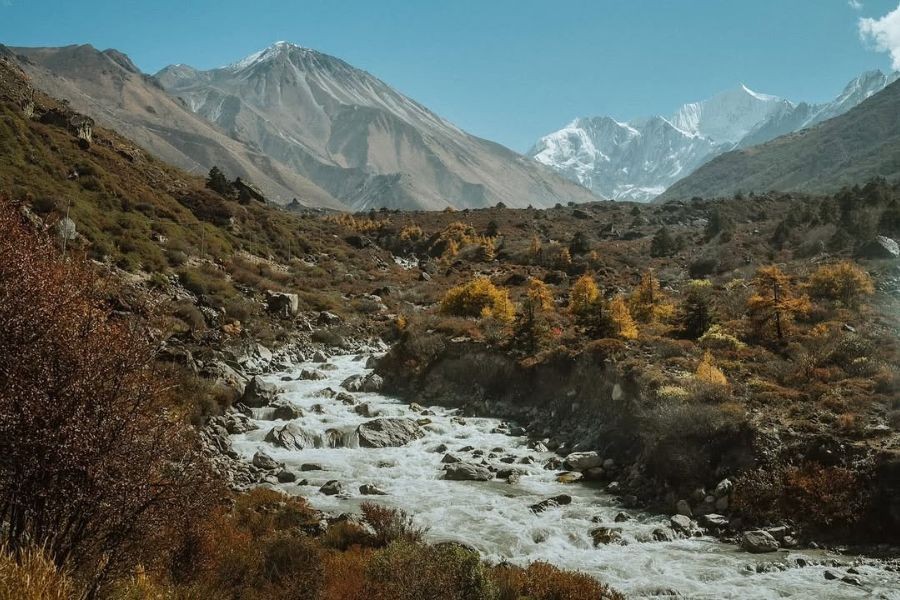
Langtang Valley Trek in March
The Langtang Valley trek in March indicates the beginning of the main trekking season. The first week of March may still have some winter-induced chill – specifically around Kyanjin Gompa and higher, but mid-March onward, the weather continues to improve. March presents the following benefits:
- Weather: Daytime temperatures between 8-18°C can be expected with an increasing chance of sunny skies
- Crowds: Lower numbers of trekkers than peak season therefore trails are peaceful and teahouse bookings easier
- Floral: Beginning of early flowering of rhododendrons in lower elevations, though peak flower happens later
- Trail Conditions: Recognizable routes to follow with little snowfall below Kyanjin Gompa
- Visibility: Spectacular mountain views with clear crisp air
- Snow Coverage: Possible snow in some higher viewpoints, therefore be prepared
March is a great time as a trekker to have a greater chance of being by yourself, along with pleasant camping and trekking weather. With the moderation of the evening temperatures into warmer and moderate weather during the day, it provides the ideal opportunity for evening star gazing under a calm and clear mountain atmosphere.
- Article you may like: The Ultimate Guide to Langtang Valley Trek in Autumn
Langtang Valley Trek in April
In April, the trekking season comes into full bloom on the Langtang Valley trek, which many say, is the most perfect time of the year to trek the Langtang Valley. Here are the key factors why most trekkers say April may be the perfect month to trek the Langtang Valley:
- Weather: Great daytime trekking temperatures around 12-20 degrees Celsius
- Flora: The blooming season for rhododendrons and vibrant colors throughout the valley
- Visibility: Gorgeous blue sky afternoons with very limited clouds, predominately in the mornings
- Trail Conditions: Great trails, pathways, and dry weather
- Wildlife: Active bird life and increased likelihood of wildlife sightings
- Cultural Activities: Spring festivals and Sherpa/Tamang activities
- Photography: Perfect lighting with clear mountain views
- Teahouses: All teahouses functioning and food supply available
April is considered the sweet spot for trekking to Langtang Valley in the spring tri-season, mainly because of the combined offerings of weather, views, and special events. A consistent month of creating favorable weather, reduced risk, and ideal conditions for photographers and beginner trekkers alike.
Langtang Valley Trek in May
The Langtang Valley trek in May wraps up the spring season in warm stable conditions before the arrival of the monsoon season. Late spring offers some unique advantages:
- Weather: This gives you the warmest temperatures of the spring season, 15-22°C, with long daylight hours
- Visibility: Generally, mornings are clear with clouds expected to build up in the afternoon
- Flora: Late spring brings flowers and encourages lush green landscapes; especially at alpine meadows; it’s a great chance to see all the flowers that are now blooming
- Trail Conditions: Trails are dry but gravitating towards the lower elevations will see increasing warmth
- Photography: Longer golden hours for mountain photograph in the morning and the late afternoon
- Prep: May is the last chance to get a trek in before monsoon begins in June
- Glacier Features: The best time of the year to see glacial features and ice before melting takes place
- Viewpoints: Warm conditions make it easier to climb to high-altitude viewpoints, which are uncomfortable in cooler weather
May provides fantastic trekking conditions for warmer-weather enthusiasts, but trekkers should be amenable to the possibility of rain showers as they may experience pre-monsoon rain events later in the month, especially in the afternoons. Early May conditions provide fantastic trekking opportunities; late May requires a flexible plan.
- Article you may like: Langtang Valley Trek in Winter: Your Complete Guide to a Magical Himalayan Adventure
What to Expect on the Langtang Valley Trek in Spring
The difficulty of this trek can be considered moderate; it is suitable for a conditionally fit beginner. Maximum altitude is 3,870m at Kyanjin Gompa (viewing points up to 4,984m). Spring offers stable conditions conducive to acclimatization.
You can expect a mixture of adventure and spirituality - from walking on glaciers near Kyanjin Gompa to trails lined with prayer flags and monasteries. There is a good chance to see wildlife early in the morning.
Why the Langtang Valley Trek in Spring is Worth It
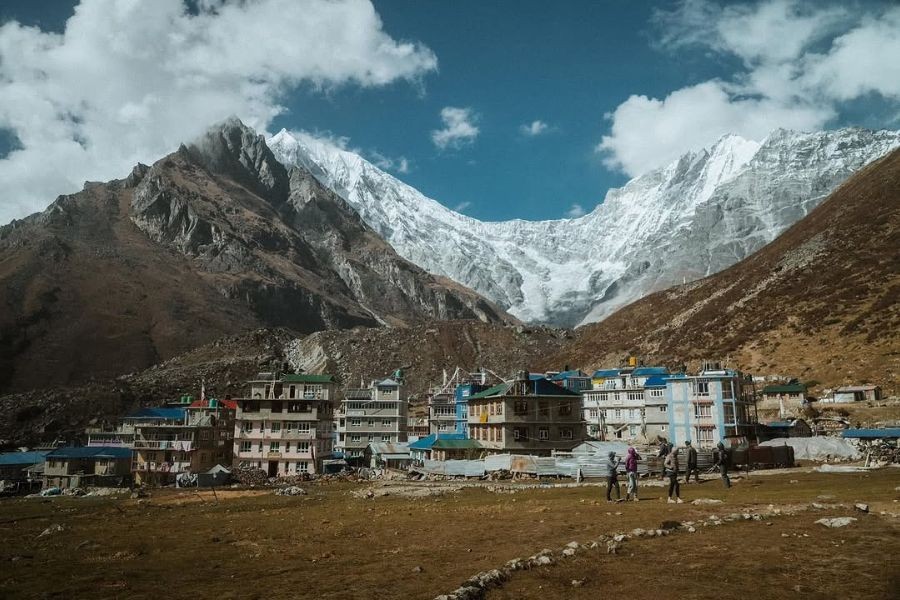
The Langtang Valley hike provides a wonderful combination of access, scenic views, and cultural experiences in the spring. Trekkers can enjoy the rhododendron-lined trails, warm Tamang settlements, and spectacular views of Langtang Lirung — all less than a few hours travel from Kathmandu. It is perfect for anyone looking for an authentic experience in the Himalayas without the elevations associated with other hikes.
As the valley blossoms, there is a sense that each sunrise over the Langtang range acts as a blessing of nature. The Langtang Valley Trek in the spring season is not simply a trek, but a renaissance of the Himalaya.
- Article you may like: Langtang Valley Trek in Summer: Weather, Tips & Complete Guide (June–August)
Conclusion
From the crimson rhododendrons of March to the emerald-laden meadows of May, the Langtang Valley Trek showcases Nepal in all of her glory. Whether it is your first trek or you are returning to this area of the Himalaya, a trek through Langtang will immerse you in a spectacular landscape with authentic warmth of culture.
Please join our Ecologically Friendly Langtang Valley Trek with Himalayan Ecological Trekking in the spring season: Explore the lush blooming landscapes of Nepal, peaceful hiking, and authentic mountain culture with trusted local guides.
Frequently Asked Questions
Why is spring the best time for the Langtang Valley trek?
Spring (March-May) is the prime trekking season in Langtang Valley, as the weather is ideal for trekking with temperatures varying from 10-20 degrees Celsius. You will have crystal clear mountain views of Langtang Lirung and other mountains in the region, and you will get to see the best rhododendron blossoms. [Unlike the Everest and Annapurna regions, you will experience relatively fewer trekkers on the trails, stable weather conditions throughout the trip, and you will be walking the season when the most spectacular mountain views of Langtang Lirung and the entire Himalayan range are standard for the Langtang Valley Trekking trip.]
What are the main differences between March, April, and May for the Langtang Valley trek?
March: Pleasant, relatively cooler temperatures (8-18°C), fewer trekkers, the budding of early rhododendron wildflowers, and potential for snow at higher elevations around Kyanjin Gompa.
April: Peak season with the most amazing trekking conditions (12-20°C); everything rhododendron flowers; the most stable weather conditions (best for all trekkers and photographers).
May: Warmest temperatures (15-22°C), much of the landscape is lush, longer days, wildflower and alpine meadow flowers in bloom, and the last chance before the weather conditions change since the beginning of the pre-monsoon season.
Each of the months of the Langtang Valley in the spring season has different advantages for each party's various preferences and trekking styles.
How difficult is the Langtang Valley trek in spring?
The Langtang Valley trek in the springtime is moderate difficulty, suitable for beginners who desire a basic level of fitness to travell until the end of the trek, maximum altitude of 3,870m at Kyanjin Gompa (optional viewpoints of up to 4,984m), including 5 - 7 hours of varied terrain treking and walking each day. The trek itself does not necessitate any technical climbing. Spring has a better potential for stable weather and average comfort temperature, and with proper acclimatization, is easier compared to other seasons which is ideal for first-time trek in the Himalaya.
What should I carry for trekking in Langtang Valley in springtime?
First thins first, be prepared to consider the backpacking essentials for Langtang Valley trek in springtime: a layered clothing system including light and heavier layers of clothings (a warm down/fleece jacket for the evenings), waterproof trekking boots, a sleeping bag atleast rated to -10°, a pair of high-SPF sunglasses, sunscreen (preferably high), light rain jacket, trekking poles, and headlamp. You can expect -5° C at night, especially at an altitude, but highs up to 20° C during the day at lower elevations. Expect a less heavy winter gear pack and overall spring conditions compared to trekking in any other season, but expect variable conditions associated with high altitude.
Where to stay on the Langtang Valley trek in spring?
Traveling to Langtang Valley in the spring season provides basic teahouse accommodation run by Tamang families, the rooms are basic but clean, they provide shared bathrooms, warm blankets, and common dining areas with heat. Teahouse menus have options like traditional dal bhat, momos, Tibetan bread, noodle choices, and some international selections. The spring season provides the best variety of food and teahouses operating at full capacity with fresh supplies. Kyanjin Gompa will provide the best selection of accommodation options for acclimatization and rest days.
Is it safe to visit the Langtang Valley for trekking since the earthquake in 2015?
Yes! The Langtang Valley has been fully rebuilt and is completely safe for trekking. The trails are in good infrastructure, and teahouses and villages have been rebuilt to higher standards than before. The local people have worked tirelessly to restore the valley, and trekking there contributes to their overall recovery and livelihood. Spring conditions provide reliable weather and dry trails for an optimal trekking experience in this amazing valley that has shown resilience.
Ready to Experience Langtang Valley in Spring?
Book your adventure today for an unforgettable spring Himalayan journey through the Valley of Glaciers with Himalayan Ecological Trekking!
Inquire Now: [email protected]
Expert Consultation: WhatsApp: +977 9851006023 (Bikesh)
.jpg)
